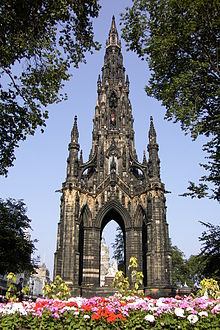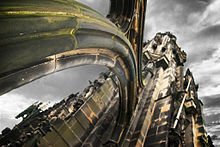- Scott Monument
-
The Scott Monument is a Victorian Gothic monument to Scottish author Sir Walter Scott (not to be confused with the National Monument). It stands in Princes Street Gardens in Edinburgh, opposite the Jenners department store on Princes Street and near to Edinburgh Waverley Railway Station.
The tower is 200 feet 6 inches (61.11 m) high, and has a series of viewing decks reached by a series of narrow spiral staircases giving panoramic views of central Edinburgh and its surroundings. The highest viewing deck is reached by a total of 287 steps (those who climb the steps can obtain a certificate commemorating the event). It is built from Binny sandstone quarried in nearby Ecclesmachan. This oily stone was known to attract dirt quickly and was probably a deliberate choice to allow the Gothic form to quickly obtain the patina of age. Arguably the soot of Edinburgh's chimneys, in combination with smoke from the nearby railway line and Waverley Station perhaps over-egged the result, and it is now very hard to make out the numerous carved figures. Bill Bryson has described it as looking like a "gothic rocket ship".[1]
Contents
History
Following Scott's death in 1832, a competition was held to design a monument to him. An unlikely entrant went under the pseudonym "John Morvo", the name of the medieval architect of Melrose Abbey. Morvo was in fact George Meikle Kemp, forty-five year old joiner, draftsman, and self-taught architect. Kemp had feared his lack of architectural qualifications and reputation would disqualify him, but his design (which was similar to an unsuccessful one he had earlier submitted for the design of Glasgow Cathedral) was popular with the competition's judges, and in 1838 Kemp was awarded the contract to construct the monument.
John Steell was commissioned to design a monumental statue of Scott to rest in the space between the tower's four columns. Steell's statue, made from white Carrara marble, shows Scott seated, resting from writing one of his works with a quill pen and his dog Maida by his side.
The foundation stone was laid on the 15th of August 1840. Following an Act of Parliament permitting it (the Monument to Sir Walter Scott Act 1841 (4 & 5 Vict.) C A P. XV.), construction began in 1841 and ran for nearly four years. The tower was completed in the autumn of 1844, with Kemp's son placing the finial in August of the year. The total cost was £16,154/7/11.[2] When the monument was inaugurated on the 15th of August 1846, George Meikle Kemp himself was absent; walking home from the site on the foggy evening of the 6th of March 1844, Kemp had fallen into the Union Canal and drowned.
Modern administration
In the 1990s, the monument was closed periodically for restoration work: In the early 1990s it was covered in scaffolding for several years, and it was closed again for additional work in 1998/99. For these purposes, the original quarry was re-opened to get matching sandstone from which craftsmen carved the necessary replacements. Proposals to stoneclean the monument as part of the restoration were shelved owing to the controversy as to whether it was designed to be clean or dark.
The overall cost of the restoration was £2.36 million and was funded by the Heritage Lottery Fund, Historic Scotland and the City of Edinburgh Council.[2]
The monument is now administered by the Culture and Sport division of the City of Edinburgh Council, although the cost of restoration led to discussions in 1996 about selling the landmark to private interests.[3][dead link]
References
- ^ Bill Bryson, Notes from a Small Island Ch. 25
- ^ a b As stated on an information panel in the monument
- ^ Nigel Burnham (21 March 1996). "City may sell off Scott memorial crumbling landmark". The Independent (London). http://www.findarticles.com/p/articles/mi_qn4158/is_19960321/ai_n14037188. Retrieved 23 June 2007.
External links
Coordinates: 55°57′8.7″N 3°11′35.8″W / 55.952417°N 3.193278°W
Categories:- Buildings and structures completed in 1844
- Buildings and structures in Edinburgh
- Category A listed buildings in Scotland
- Visitor attractions in Edinburgh
- Monuments and memorials in Scotland
- Walter Scott
- Listed buildings in Edinburgh
Wikimedia Foundation. 2010.



